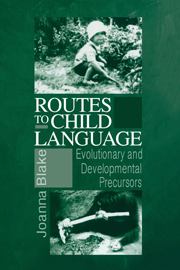Book contents
- Frontmatter
- Contents
- Preface
- 1 Prelinguistic Vocalizations
- 2 Sound–Meaning Correspondences
- 3 Communicative Gestures
- 4 Symbolic Gestures and Symbolic Play
- 5 Tool Use and Object Concept
- 6 Representation in Human Infants
- 7 Memory in Nonhuman Primates and Young Children
- 8 Origins of Language
- 9 Recapitulation
- References
- Index
4 - Symbolic Gestures and Symbolic Play
Published online by Cambridge University Press: 12 January 2010
- Frontmatter
- Contents
- Preface
- 1 Prelinguistic Vocalizations
- 2 Sound–Meaning Correspondences
- 3 Communicative Gestures
- 4 Symbolic Gestures and Symbolic Play
- 5 Tool Use and Object Concept
- 6 Representation in Human Infants
- 7 Memory in Nonhuman Primates and Young Children
- 8 Origins of Language
- 9 Recapitulation
- References
- Index
Summary
In Chapter 3, I made a distinction between communicative and symbolic gestures because the primary function of symbolic gestures is to represent an object or an action rather than to communicate. My distinction is similar to one made by Erting and Volterra (1990) and by Goldin-Meadow and her collaborators (Goldin-Meadow & Morford, 1985; Goldin-Meadow & Mylander, 1984), who used the term characterizing or pantomimic for symbolic gestures. However, they included in the characterizing category such gestures as holding out the hand to request an object, which we have called reach-request (see chapter 3). Symbolic gestures have also been labeled enactive (Zinober & Martlew, 1985, after Bruner, 1964), referential (e.g., Camaioni et al., 1991; Caselli, 1990), depictive (Werner & Kaplan, 1963), and iconic (McNeill, 1992; Tanner & Byrne, 1996). Iconic gestures refer also to a category of hand movements that accompany speech and are thought to evolve out of infant symbolic gestures (McNeill, 1992); these are called illustrators by Ekman and Friesen (1969).
Because symbolic gestures represent objects, Goldin-Meadow and Mylander (1984) required that they be performed with no object in hand. Most researchers, however, allow objects in the hand that either substitute for prototypical objects (for example, a block for a doll's bottle) or are part of an action involving a missing realistic ingredient (for example, feeding a doll with a spoon but no food).
The distinction between communicative and symbolic gestures is not always a firm one, of course, because symbolic gestures are sometimes communicative, particularly of the infant's desires.
- Type
- Chapter
- Information
- Routes to Child LanguageEvolutionary and Developmental Precursors, pp. 111 - 139Publisher: Cambridge University PressPrint publication year: 2000



